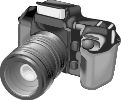No digital camera is created equal. Each has its own set of features and limitations. However, within the realm of photography, digital cameras are far less uniform than traditional film equivalents, making the selection of a digital camera often very difficult. One of the most diverse attributes of digital cameras is the type of camera card (analogous to film) to use.
Very few cameras support more than one camera card type. Each type has its own set of features and capabilities, making the selection even more difficult.
There are several types of digital camera cards (often referred to as memory cards):
- Compact Flash (CF). Compact Flash is a very mature camera card that sport high capacities, excellent reliability and excellent performance. There are two types of Compact Flash cards: Type I and Type II. Type I cards are 3.3 mm thick, whereas the newer Type II cards are 5.5 mm thick. Type I cards can be used in cameras that utilize the Type II cards. However, Type II cards can only be used in Type II capable cameras.
- Microdrives. A microdrive is literally a miniature hard drive housed inside Type II Compact Flash housing, and can be used in a majority of Type II capable cameras. Although microdrives have long provided the greatest capacities, newer Compact Flash cards have surpassed the microdrive, which sport capacities in excess of 4 gigabytes (GB). Many microdrives still have a lower cost-per-byte when compared to some high-capacity Compact Flash cards, but have higher power requirements than other camera cards.
- Secure Digital (SD). Secure Digital cards are becoming the most popular digital camera media and are less than half the mass of a Compact Flash card. These cards have traditionally been less capable than their Compact Flash predecessors, simply because of their young age. However, the SD standard has recently undertaken major developmental leaps and bounds and is quickly catching up to the Compact Flash in speed and capacity, with cards that exceed two gigabytes (GB). Second generation SD cards, often referred to as high-speed SD, provide much faster speeds than the first generation SD standard.
- Multimedia Card (MMC). MMC cards were a precursor to the now-famous Secure Digital (SD) cards and are no longer as common as they once were. Externally, MMC is identical to SD. Internally, however, they are very different. MMC is much slower and far less capable than SD. Some SD-capable cameras, however, are compatible with the older MMC cards.
- xD Picture Card (XD). XD cards, primarily developed by Fujifilm and Olympus, are designed to be ultra-compact and very light-weight. XD comes in various capacities, from 16 megabytes (MB) up to several hundred megabytes, with the potential for gigabyte capacities. There have been claims that XD falls short on performance when compared to SD and Compact Flash. Others have claimed that XD suffers from oxidation issues. Although these claims are still up for debate, the fact remains that XD has yet to be highly popular, and is uncommon in cameras other than Olympus and Fujifilm.
- Memory Stick. The Memory Stick was developed exclusively by Sony for a wide array of uses among digital Sony products (cameras, media players, etc). The Memory Stick Pro sports faster speeds and higher capacities, but are rarely (perhaps never) supported in anything but Sony products.
- Smart Media. The Smart Media card was developed a number of years ago by Olympus and Fujifilm. However, due to reliability issues and capacity limitations, Smart Media is being phased out in favor on the newer xD standard.
Have comments or suggestions for a weekly Tech Tips article? Send an email to webmaster@sunad.com.

